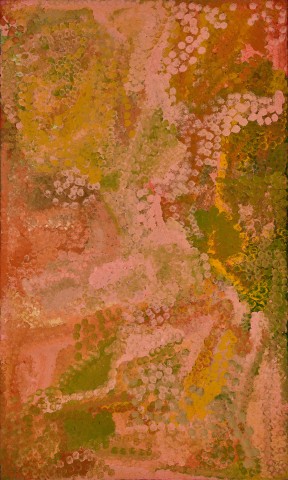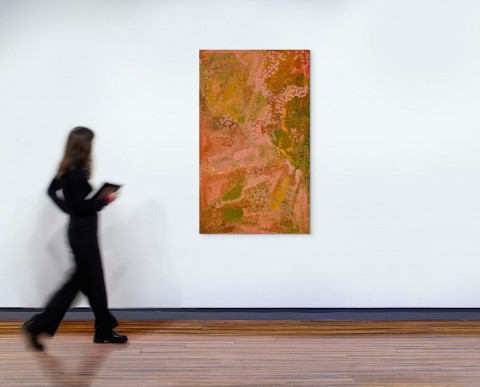UNTITLED (EMU COUNTRY), 1993
EMILY KAM KNGWARREYE
synthetic polymer paint on canvas
152.0 x 91.5 cm
bears inscription verso: artist’s name and Delmore Gallery cat. 93A171
Commissioned by Delmore Gallery, via Alice Springs, Northern Territory in 1993
Songlines Gallery, San Francisco, USA
Private collection, New York, USA, acquired from the above in September 2007
Songlines Aboriginal Art: Utopian Visions, Art 1999 Chicago, Chicago, USA, 7 – 11 May 1999
This painting is accompanied by a copy of the certificate of authenticity from Delmore Gallery.
Renowned for her colourful and vibrant recording of the ever-changing desert landscape in her father and grandfather’s Country of Alhalker, Emily Kam Kngwarreye chronicled on canvas her custodial responsibility for the Yam and the Emu – reflecting her connection to country and Women’s ceremonies through body painting and dance. Located at the western edge of Utopia this triangular shaped country was where Emily was born and where she lived in the traditional ways of the eastern Anmatyerr, following a way of life that had continued unchanged from long before European presence. Her mark making recorded the seasonal variations, sometimes subtle but often dramatic, of the harsh desert environment and the explosion of growth that occurred after rain. Referred to by Emily as the ‘green time’1, the desert would come to life, wildflowers carpeting the red earth and plants and grasses flourishing, supplying the women with seeds, tubers and fruit.
With her distinctive use of pattern and colour, Kngwarreye had seemingly endless variations to call upon in the depiction of her country. Her paintings would often dissolve into fields of layered colour achieved through a build-up of dots upon dots as in Untitled (Emu Country), 1993 – in this case, a tracery of soft milky pink dots hover over an underlying ground of green, yellow and red dots. 'This is Emu Country - called Alalgura (sic.) where the male emu's role is to look after the emu chicks and keep them in sight of their home and not beyond their preferred seeds and fruits. These foods include the Nterkwe, a small purple-blue plum, and the Anooralya, a long, thin yam with a small flower.2
Kngwarreye bears witness though her painting to that abundance that carpets the earth after rain, sustaining country and celebrating the hardiness and fertility of their bush tucker and food sources, and in turn, her people’s own resilience.
1. Isaacs, J., ‘Amatyerre Woman’ in Isaacs, J. et al., Emily Kame Kngwarreye Paintings, Craftsman House, Sydney, 1998, p. 13
2. Cited in the accompanying certificate from Delmore Gallery
CRISPIN GUTTERIDGE

